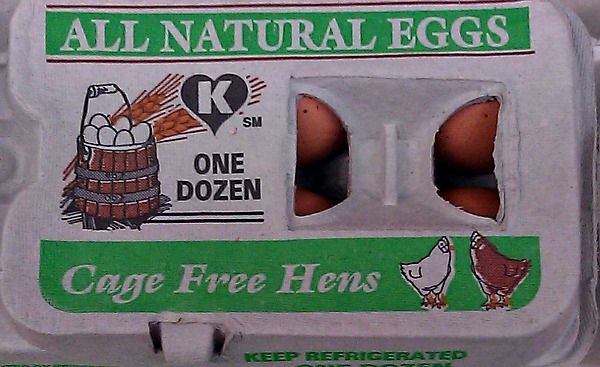 Meat and eggs labeled as “free range” or “cage free” have become increasingly popular in recent years as consumers try to source higher quality food for their families as well as to vote with their food dollars for humane and “green” conditions for the chickens themselves.
Meat and eggs labeled as “free range” or “cage free” have become increasingly popular in recent years as consumers try to source higher quality food for their families as well as to vote with their food dollars for humane and “green” conditions for the chickens themselves.
When most people think of free range, cage free chickens, they get a picture in their mind of happy chickens outdoors in the open air, completely free to express their chicken-ness by clucking around and pecking in the dirt for grubs and insects.
The truth of the matter is something else entirely. In fact, one of the more popular posts on the Healthy Home Economist Facebook page recently was a picture of the actual living conditions of free range, cage free chickens.
After seeing this Facebook post, Susan O. a reader who rescues “free range” chickens from commercial operations, sent me a series of shocking photos. Here are the photos along with her description of what these poor chickens endured, which turns out to be not much better than regular battery hens in cages.
Susan’s own words describing the 3 rescued “free range” hens – at only 1 year old:
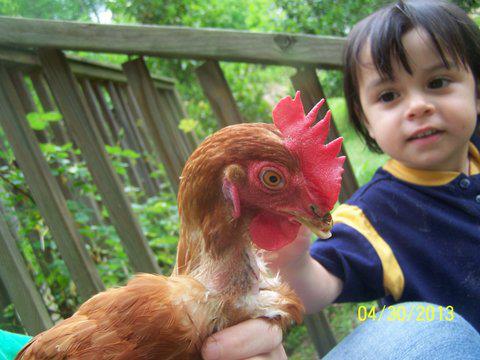
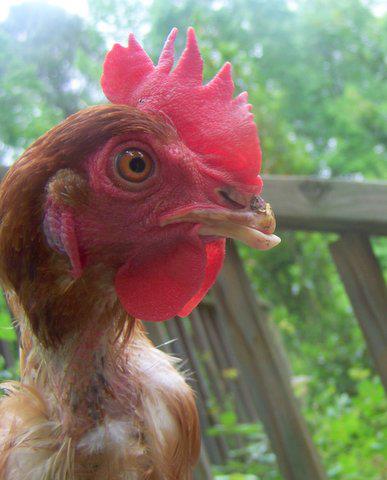
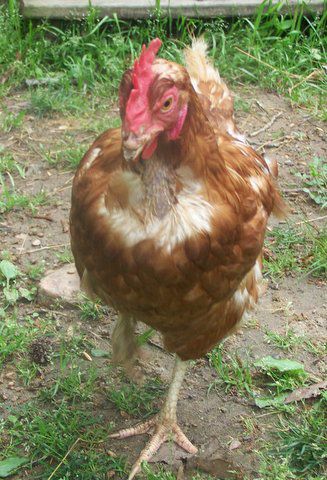
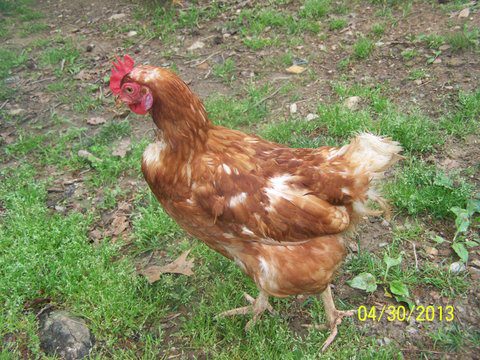
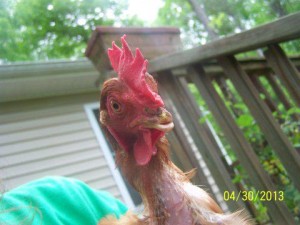
We “rescued” 3 hens from a commercial supplier who had one year old spent hens they wanted to sell. Their breed is Isa Brown.
The eggs were sold as “free-range” and “cage-free”.
We had no direct contact with the main supplier. It was very difficult to get the hens. Another person who purchases mass amounts of the hens from the egg supplier for $1.00 each was tracked down and he agreed to sell them to a group of rescuers for $10.00 each.
We’ve had these hens for a little over a month and they look much better then they used to. These photos were taken last week. When they arrived they were in much worse shape.
They’d never been outside, had no idea how to act like chickens. They wouldn’t roost at night, just pecked and walked around all night long.
I suspect their “house” was kept lit almost 24 hours a day for greater egg production. They pecked EVERYTHING. Trees, plastic, metal.
They were clueless. I had to cut their toenails. They were over an inch long!
One was limping her toenails were so long. They all had hen mites. All have feather loss. The combs on their heads were not the color they are now, but very pale, a sign of anemia and malnourishment.
The red fleshy part near the ear area was white and is still a little white today. Their eggs were without shells, had only a membrane on the outside from extreme calcium deficiency.
Another rescuer said her hen laid an egg and it broke inside her. They’ve also had their beaks cut. These hens will need to be on a special diet. They can’t crack corn or seeds with their beaks or pick up regular feed that’s not crumbled.
It’s like removing a human’s four front teeth and telling them to eat. They’ve learned to become very efficient at grabbing worms out of our compost bin. They are very gentle animals. We can pick all of them up and pet them.
People need to understand that the meat industry sees an animal as simply a product, to be used until they’re spent, then discarded like trash. The last thing the industry is worried about is our health and providing us with nutritious food.
We have a small homestead and do raise chickens and rabbits for meat, but these rescued ladies have a “free pass” to enjoy being chickens for as long as they live.
When friends shake their head and say “I couldn’t do it ” when I tell them about raising animals for meat, I draw the comparison between my healthy hens and these poor rescue hens.
If these “cage-free” hens were in this bad of shape at only one year old, I shiver to think how bad a typical battery hen would be. And no doubt, the gentleman gave us the better looking hens. Not everyone can afford pastured meat (but we manage, even on a budget 200% of the federal poverty guidelines and without taking any government assistance ), but pastured eggs can be afforded by most.
What Does a Healthy Chicken Actually Look Like?
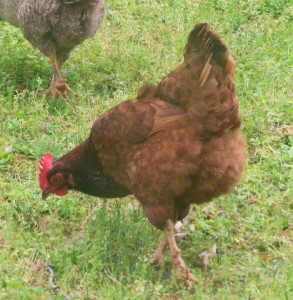 This is a photo of one of Susan’s long-time yard hens. She’s a comparable breed to the Isa Brown. She’s been truly free range since the day she was born.
This is a photo of one of Susan’s long-time yard hens. She’s a comparable breed to the Isa Brown. She’s been truly free range since the day she was born.
Note the tremendous difference between the two, “cage free” store label hen vs truly free range hen. No missing beak, feathers, white spots or mite infestation. The happy chicken is focused on the ground, pecking for insects and grubs instead of the pathetic, sad, vacant stare that signifies the horrifying animal abuse endured by chickens whose meat and eggs are labeled “free range” at the store.
In order not to be fooled into thinking your chicken and eggs come from happy birds like this one to the right when they actually come from beakless, anemic, mite ridden animals that have been so abused they can’t even peck in the dirt or crack corn, resolve to buy local!
When you buy from a neighbor or small scale local farmer who raises chickens, you can see them for yourself and note their health by the living conditions.
Abdicating responsibility for knowing exactly where your food comes from by trusting meaningless food labels in a store that proclaim eggs or meat as “free range” or “cage free” is not helping to secure quality food for your family nor is it helping to promote the cause of humane conditions for farm animals.
Sarah, The Healthy Home Economist








To produce top quality eggs and meat, chicken need lots of room and a varied landscape of pasture, brush and woodland. They need plenty of exercise and copious amounts of worms, bugs, grass, seeds, and fruit. They need to be out in the sunshine. They need endless opportunities to explore and enjoy the outdoors. They do best with acres of space. Give them plenty of space and there are no problems with pecking. If they are pecking each other, they are too confined. They also need the time to grow into mature birds to reach full flavor and have a decent meat texture. None of this comes cheap, and the powers that be have decided that the only thing people should eat is inexpensive, low quality chicken raised in deplorable conditions. Chicken doesn’t have to be this way. I’ve specialize in mother-hatched, mother-raised chicken, and the eggs and meat from my flock is nothing like the eggs and chicken sold in any store. Sadly, there is almost no one raising chicken this way, and just a tiny, tiny percentage of consumers ever get to experience how wonderful eggs and chicken can be. http://amanandhishoe.com
fml
ur totes means too Kate Millsas
da flng is mtrl
STOP!!! HAMMERTIME $$$
yo r totes mean cristel krayHE!
why wnt yo reply toh meh
awks
This is like totes sad! D:
This is all well and good but most us would have to drive miles even if we could find a place to buy them. Please dont judge us for not doing it!!!!!!!!!!!!
The USDA regulations to qualify as “free ranging” only requires that the chicken have 12 inches by 12 inches to walk around in. The chicken can spend it’s entire life indoors except the last 9 weeks of it’s life and that is called “free ranging”. These rules also apply to USDA organic standards for “cage free” chickens.
It is GREENWASHING.
If you really want pastured eggs you need to buy them DIRECT from the chicken rancher. The best way is a CSA produce box and buy some eggs as an add on item. Authentic pastured top quality eggs do NOT feed their chickens soy. I pay around $7.00 for a dozen non-soy pastured eggs that are genuine free ranging. Yeah, it’s expensive but it breaks down to only 58 cents an egg. 2 eggs is enough protein for one meal and at $1.16 for the protein portion of my meal that is a bargain. I get my pastured soy free eggs from a local organic farmer who does farmers markets and CSA boxes. She feeds her hens sprouted chia, sprouted flax, seaweed powder and sprouted barley grass. There is some other stuff in her feed for nutrition but NO SOY and NO CORN. There is a lot of low quality so called organic animal protein that I don’t think is sustainable. Cows are ruminants – they have several stomachs – most organic dairy and livestock is feed organic corn and soy. Soy is an endrocrine disruptor and should be FERMENTED. I don’t eat tofu, don’t eat soymilk – if I eat soy it is always fermented – like miso, tamari, tempeh, natto. It isn’t healthy for humans to drink soymilk out of a box that’s been sitting on a shelf six months and it isn’t healthy for livestock to eat soy. A little bit of organic corn is ok for chicken feed – but they really need to eat sprouted flax/chia and sprouted wheatgrass, barley grass, etc.
All this “greenwashing” with the phrase free range is along the lines of people who think “Natural Gas” is eco-friendly and sustainable – natural gas is a fossil fuel and not renewable energy – the same way egg labels stating “cage free” don’t mean anything. Cage free can only give the chicken 12 inches to walk around in! Electric hybrid cars are only slightly better than gasoline cars, but are touted as “green” and eco-friendly.
It makes me very sad there is so much BALONEY touted as organic, eco-friendly when in reality it is just greenwashing.
Natural gas is a great environmental way to power things because it is already there and does not need to be produced, and serves no purpose so if it ever did run out then AFTER that we can switch to something that’s not as good and there are no negative effects from running out of it.
Flax is worse then soy. It has all of the bad antinutrients that are in soy only in higher quantities. Do NOT eat (or feed animals that you will eat from) flax!
Please don’t ignore the fact that male chicks are pretty much useless to the egg industry. Male chicks are ground up alive at birth or stuffed in bags to suffocate. They are the ignored side of the egg industry.
If you look around, you can find farmers who don’t destroy male chicks at birth. I specialize in mother-hatched, mother-raised chicken. About half of the chicks which hatch are roosters, but they grow up to be great meat birds between five and seven months of age. They do become problematic as they near one year of age, and start fighting with other roosters for dominance. But this can be kept to a minimum by carefully selecting the most gentle roosters to keep around, and culling the others for the table. They make great roasters and after they are a year old, they are better canned or pressure cooked. The result is a very tender, duck-like meat which is so good I’m surprised more farmers don’t raise them. http://amanandhishoe.com